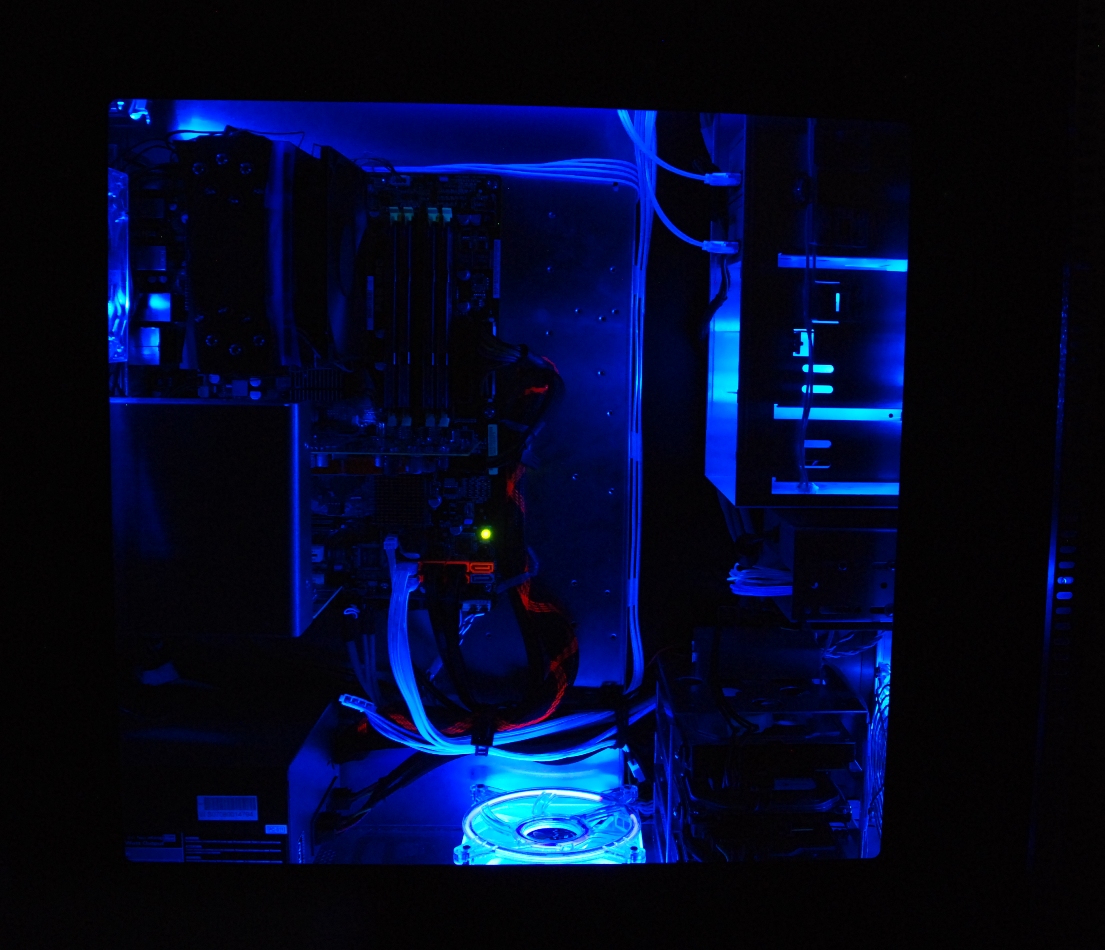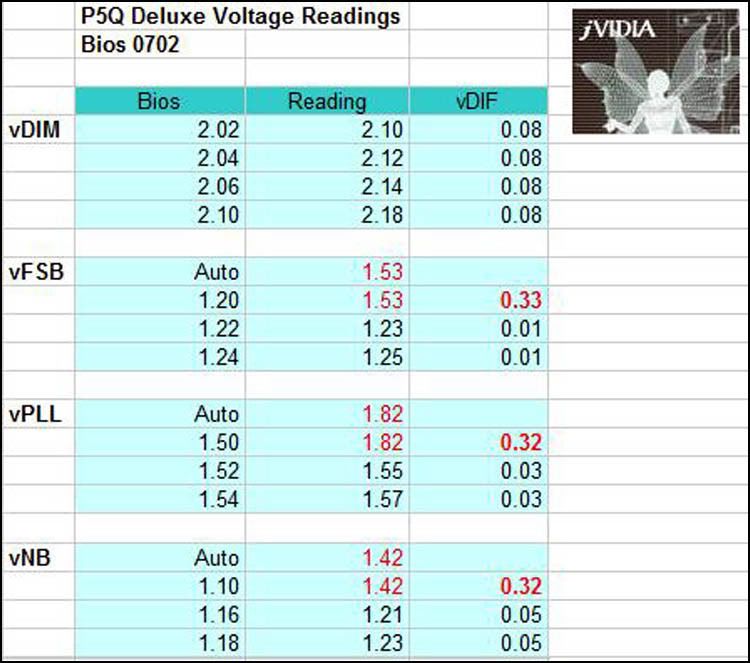crabnebula: Apparently our issue can be resolved by upping vtt a bit.
http://www.xtremesystems.org/Forums/showpost.php?p=3302242&postcount=416
http://www.xtremesystems.org/Forums/showpost.php?p=3302242&postcount=416
Follow along with the video below to see how to install our site as a web app on your home screen.
Note: This feature may not be available in some browsers.
is there some overclocking difference between P5Q Pro and P5Q-E? P5Q Pro is on sale thats why I'm asking.

I have a problem using 6GB of ram on XPx64 on a p5q-E and would like everyone's opinion as to what is going on.
I was at 2GB 3:2 4ghz PL8 w/ pullins
I am now at 6GB 1:1 4Ghz PL10 w/ pullins higher voltages
I am not able to address all 6GB in windows I see ~5.5GB, in fact using 4GB I see ~3.5GB. cpu-z sees entire memory.
My questions are am I really using all my memory? Is there some overhead I don't know about? Do I need to remap memory hole (thx scabar) and how do I do that?
What windows do you have? 32 or 64 bit? Vista or XP?
Can someone give me some pointers to adjusting VTT NB voltage and GTL settings in my P5Q Pro with my Q6600? I would like to get 3.6ghz stable but right now it isn't even with a 1.5v vcore and I don't want to take the vcore any higher(I haven't touched any other settings, ram is at 1:1)
What's the VID of your Q6600? I've got a 1.325V VID Q6600, rock solid at 3.1Ghz so far, stock voltage, Ultima 90.
http://i37.tinypic.com/e6op6v.jpg
http://i33.tinypic.com/25a7os3.jpg
Realtemp calibrated at 264x6 and a .984v vcore to 6C above ambient(17.7C) at idle.
Bios Settings:
vcore: 1.52v
VTT: 1.38v
NBv: 1.40v
FSB:RAM 1:1
Everything else was on auto
Any suggestions? I think its obvious I shouldn't set the vcore any higher, I'm already knocking on the door of 65C under load and that is the hottest I will ever let my Q6600 get.
For reference my case has 3x120mm intake fans, 3x140mm+1x120mm+HD4870 exhaust fan, temperature of the room the PC is in is 64F. Xigmatek hdt-s1283
Define "load". My Q6600 hits 64-65C at 3.1Ghz, ONLY when Prime95 v25.6 is running on all four cores 100% load. Else, it varies between 55 and 60C max. Tried undervolting the chip?
http://i37.tinypic.com/e6op6v.jpg
http://i33.tinypic.com/25a7os3.jpg
Realtemp calibrated at 264x6 and a .984v vcore to 6C above ambient(17.7C) at idle.
Bios Settings:
vcore: 1.52v
VTT: 1.38v
NBv: 1.40v
FSB:RAM 1:1
Everything else was on auto
Any suggestions? I think its obvious I shouldn't set the vcore any higher, I'm already knocking on the door of 65C under load and that is the hottest I will ever let my Q6600 get.
For reference my case has 3x120mm intake fans, 3x140mm+1x120mm+HD4870 exhaust fan, temperature of the room the PC is in is 64F. Xigmatek hdt-s1283
Well I can run a 437 FSB with all related voltages on auto, so I'd say you need to back off your clocks a bit. I can't do 9x400 on mine either, core #2 is my weak link (cores 0 and 1 can do it at 1.375v, core 3 requires 1.4v). It's possible I could achieve 3.6GHz if I could get voltages above 1.45 working (I get reboots after 10-15 mins of prime if I go over that despite load temps never exceeding 60c, and core 2 only lasts about half an hour before failing at 1.45), but really it isn't worth it. Stepping down to 8x437 got me 24h stable at 1.4v and with much better temps (49c). Maybe try something around that mark. My VID is 1.325v btw, so I wasn't expecting a huge OC from this chip.
The thing with that is you're stressing your motherboard and ram more with higher FSB, I'm trying to find my processors max stable speed that I can run safely on a daily basis so increasing FSB would cause more chances for other components to cause instability.
I tried all 6 BIOSs and the most stable one for me so far was v803. Now I have everything up and running smoothly. I recommend this BIOS version until the next official one is released.
Some of the biggest things that have helped me are raising the GTL ref and giving up on a fast 4up system. My 4 slot config hopes were dashed by slower and mismatching sticks but the chipset really does not forgive you with PL (performance level) of 13 stable 10 bootable when I was at 8/7 with 2.
e8400 with 2GB Ballistic PC8500
AI Overclock tuner: MANUAL
CPU Ratio Setting: AUTO
FSB Frequency: 454
FSB Strap to North Bridge: AUTO
PCI-E Frequency: 101
DRAM Frequency: 1076 (?ish I'm doing this from memory)
DRAM Timing Control: Manual
5
5
5
18
rest AUTO
DRAM Static Read Control: Disabled
DRAM Read Training: Disabled
MEM. OC Charger: AUTO
AI Clock Twister: Light
AI Transaction Booster: MANUAL
PL8
All Pull-ins Enabled
CPU Voltage: 1.365
CPU GTL Voltage Reference: 1/3 0.67 0/2 0.67
CPU PLL Voltage: 1.52
FSB Termination Voltage: 1.22
DRAM Voltage: 2.2 (Actively cooled. WARNING: P5q notoriously overvolt memory)
NB Voltage: 1.24
NB GTL Reference: AUTO
SB Voltage: AUTO
PCIE SATA Voltage: AUTO
Load Line Calibration: ENABLED
CPU Spread Spectrum: DISABLED
PCIE Spread Spectrum: DISABLED
CPU Clock Skew : AUTO
NB Clock Skew : AUTO
CPU Margin Enhancement: OPTIMIZED
Performance level makes a BIG difference in how the OS "feels" to me so this is one of the most important settings to me. I'll try to get AI clock to moderate with some more work but these settings have been 100% stable for me and I wanted to share.
As long as you don't force a particular strap then increasing the FSB is not really a problem unless you're going stupidly high with it - besides, you can still run a 9x multi and try lowering FSB a bit. I just prefer to run the RAM a little faster without messing with dividers (I'm only using PC-6400). 1.52v is far from being something you would 'run safely on a daily basis', especially with aircooling - I'm just trying to tell you that you've gone past your limit and need to slow things up a bit. The point I was making regarding FSB was that I'm running mine at a higher speed than you and have not touched the voltages, therefore it is unlikely that increasing NB voltages will help.
If I even want my processor to be stable at 3.4ghz I have to volt it nearly 1.5v, and its still not stable enough to pass prime.Hi Guys, first post on the boards, found this thread from another forum, great info here and it looks like almost everyone is getting amazing results. I can't seem to get over 3.2Ghz stable, its either Im doing something wrong or my CPU VID is 1.3125 and is too high to get a good overclock.
Stats:
Vista x64 Ultimate
Antec 900 Mid Tower Gamer Case
Corsair TX750W 750W
ASUS P5Q Pro LGA775 P45
Sunbeam Core Contact Freezer 4 Heatpipe Heatsink
Intel Core2 Quad 66000 [G0] 2.4GHZ @ 3.19GHZ [355 x 9 @ 1.4v]
OCZ Platinum XTC PC2-6400 4GB 2X2GB DDR2-800 CL5-4-4-15 V2.1
EVGA E-GEFORCE 9800GX2 600MHZ 1GB 2.0GHZ GDDR3
Western Digital Caviar SE16 640GB SATA2 7200RPM 16MB
Western Digital Caviar SE16 500GB SATA2 7200RPM 16MB
So I picked up my new Heatsink fan and started trying to overclock, I put everything on AUTO and tried the following...
400 fsb x 9 = BSOD
385 fsb x 9 = BSOD after seconds of loading Vista
365 fsb x 9 = BSOD after 2hrs in Prime 95. Crysis BSOD after 15mins, VCORE autos at 1.44v
355 fsb x 9 = STABLE after 10hrs of Prime 95 (blend), VCORE autos at 1.4v
Idle: CPU@23C MB@33C
Load: CPU@45C MB@38C
I wasnt really expecting the 400x9 to work but Im really surprised I couldnt even hit 385 FSB for 3.4Ghz, almost ever overclock Ive read about with this chip has attained 3.4GHZ. So I suspect perhaps I was doing something wrong, can anyone provide any advice?
Also, although I have the Q6600 Go revision it looks like ive got the ones with the high VID, its at 1.315v. Im alos pretty sure this is why I cant go higher because it puts the Voltage at over 1.4 and it gets unstable?
Can anyone provide some insight, Im not overclocking my RAM at all while doing this, as far as I know.
Thanks,
If I even want my processor to be stable at 3.4ghz I have to volt it nearly 1.5v, and its still not stable enough to pass prime.
Moral of the story, 1.325v VIDs suck.

a guy on a uk forum im a member off grabbed them from xtremesystems and posted them on it. forums.overclockers.co.uk. id heard of the boards overvolting but didnt realise just how much.you snagged those from over at XtremeSystems didn't ya

did you enable the load line calibration option in the bios? This controls the vdroop which it sounds like what you're experiencing. My voltage stays stable between idle and load. First Asus board I've ever owned that's done that as all the previous boards have required a vdroop mod.
Yes I have, but for whatever reason, usually when I'm done playing or am playing war, my vcore drops to 1.25v permanently, no fluctuations.
I wanna overclock my E8400, how can I increase the FSB??